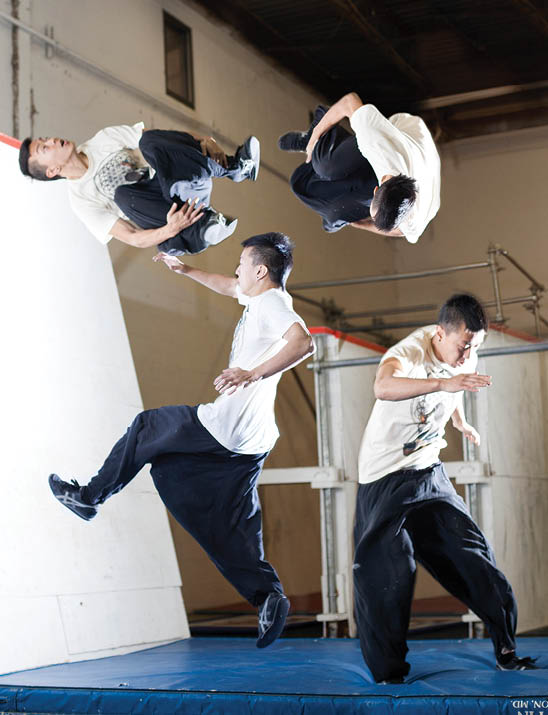A beginner class in parkour is like a crash-course in humility.
Around the room sit various walls, ledges and poles. There is a window about
20 feet up, and noticing this can set off a moment of panic—“Wait, I’m not going
to jump out of that, am I?”
No. Not today.
Not next week either. But maybe in a few years, after finishing a
master’s-level course with the body. But this? The beginner model? It’s barely
even preschool for parkour enthusiasts.
However, this particular preschool becomes exceedingly difficult when you
jump with the grace of a Clydesdale attempting to pop water balloons. After two
jumps on flat ground, it’s time to jump off a small ledge a few feet up. Injury
seems the most likely scenario.
Bend your knees. Fall. Slap the ground with your palms and never your
fingers. Fingers break, palms support. Land silently as if to creep up behind
your kid sister to place a bug in her hair.
Thud.
Never mind.
One more try.
Thud.
Surrender. Attempt the next obstacle. Jump over this barrier. Now jump over
this taller barrier. Now scale that wall. Grab a beam 11 feet off the ground and
hang there like a cat.
Nope.
Each failure will eventually lead to a success, and in that success, you’ve
begun learning the art of parkour. No matter what environment you encounter,
there is a path to your destination, and parkour is the art of finding that
path.
“Parkour is learning how to move your body through an environment as
efficiently as possible,” Mitch “Skinny” Andrejka, co-owner and instructor at
Fight or Flight Academy in Edina, says. “If there’s a 10-foot wall in your way,
how will you get over it? You could climb on top of it. You could go around
it—it’s all about what your personal body can do.”

Andrejka and Chad Zwadlo, co-owner and head instructor at Fight or Flight
Academy, have built an entire business around the people who want to try
parkour. With a free introductory class every Tuesday, Wednesday and Saturday,
Zwadlo engineered an ingenious marketing strategy by offering classes to attract
more than just hardcore parkour fanatics.
The trainers at Fight or Flight Academy offer a variety of classes, from
beginner to advanced, in parkour, martial arts and other specialties, all aimed
to teach you how to safely and efficiently navigate any terrain. Zwadlo is a
sort of godfather of American parkour. He started teaching karate in 2002,
parkour in 2007, and opened the academy with Andrejka in 2011. Parkour was
invented in the 1980s in France, but has only gained relative popularity in the
United States in the last 10 years. Television programs like American Ninja
Warrior that feature seemingly impossible obstacle courses have also heightened
the recent attraction to parkour. One previous American Ninja Warrior
contestant, David Sellers, trains at Fight or Flight Academy.
“Parkour has always been the fringe sport of the nerdy guys who didn’t get
into team sports,” says Zwadlo. “It’s an internet[-inspired] sport so it
attracts nerds.”
This is considered a compliment by guys like Zwadlo. He considers himself
part of a nerd army of video gamers, who have found a way to bring their love
for virtual reality into the real world by performing stunts that many
world-class athletes can only dream of doing.
No matter how athletic a person is, every body functions differently, and
parkour teaches people how to embrace their own movements. Some movements come
more naturally than others, and this leads to more fluidity for some. Unless, of
course, you’re the plodding Clydesdale—then nothing seems graceful.
Zwadlo has taught parkour to children and adults. But there really are no age
restrictions to parkour because the movement is tailored to each individual.
This especially suits children. Think of being a 10-year-old on the playground,
back when slides were for more than sliding and swings were often used for
catapulting into the air. That’s parkour. The fastest way to get across a
playground may be to climb a slide, jump atop a play-area roof, then swing to
the ground from the monkey bars.
Bounding across a playground is second nature to a child, whereas adults
understand the constraints of risk and the perceived limitations of their
bodies. Children see a tight space and want to squeeze through, while adults
look for the easiest and least taxing way to get through or around the same
space. It’s almost as if adults have to relearn how to be more childlike in
order to thrive at parkour.
“Parkour will help you with everything you do, but it will also show your
weak points,” says Zwadlo.
This brings us back to humility.
A first crack at parkour is certain to accentuate your failures more than
your successes. The nice thing is, you’ll look around the room and see an entire
group of people experiencing the same thing. How many people do you know that
jump over fences or scale walls every day? Probably not many.
Parkour pulls you out of your comfort zone and pushes your body to new
limits. It’s a spectacular full-body workout unlike anything else.
You’ll fail. A lot. Most of the time. Until you don’t anymore.
One certainty about parkour is that, at the end of the night, when you
finally scale an 8-foot wall and pull yourself up, you realize why you tried
parkour in the first place, and you may never want to stop.
7355 Washington Ave S, Edina, MN 55439 / 952.405.6110 /
www.fightorflightacademy.com






